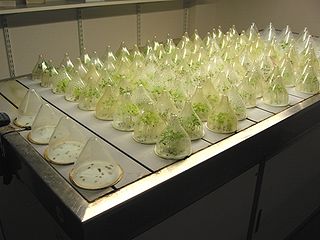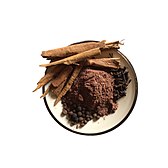
Symbiosis is any type of a close and long-term biological interaction between two biological organisms of different species, termed symbionts, be it mutualistic, commensalistic, or parasitic. In 1879, Heinrich Anton de Bary defined it as "the living together of unlike organisms". The term is sometimes used in the more restricted sense of a mutually beneficial interaction in which both symbionts contribute to each other's support.

Mutualism describes the ecological interaction between two or more species where each species has a net benefit. Mutualism is a common type of ecological interaction. Prominent examples include most vascular plants engaged in mutualistic interactions with mycorrhizae, flowering plants being pollinated by animals, vascular plants being dispersed by animals, and corals with zooxanthellae, among many others. Mutualism can be contrasted with interspecific competition, in which each species experiences reduced fitness, and exploitation, or parasitism, in which one species benefits at the expense of the other.

In biology, a colony is composed of two or more conspecific individuals living in close association with, or connected to, one another. This association is usually for mutual benefit such as stronger defense or the ability to attack bigger prey.

In biology and medicine, a host is a larger organism that harbours a smaller organism; whether a parasitic, a mutualistic, or a commensalist guest (symbiont). The guest is typically provided with nourishment and shelter. Examples include animals playing host to parasitic worms, cells harbouring pathogenic (disease-causing) viruses, or a bean plant hosting mutualistic (helpful) nitrogen-fixing bacteria. More specifically in botany, a host plant supplies food resources to micropredators, which have an evolutionarily stable relationship with their hosts similar to ectoparasitism. The host range is the collection of hosts that an organism can use as a partner.

Hormesis is a characteristic of many biological processes, namely a biphasic or triphasic response to exposure to increasing amounts of a substance or condition. Within the hormetic zone, the biological response to low exposures to toxins and other stressors is generally favorable. The term "hormesis" comes from Greek hórmēsis "rapid motion, eagerness", itself from ancient Greek hormáein "to set in motion, impel, urge on", the same Greek root as the word hormone. The term 'hormetics' has been proposed for the study and science of hormesis.
The free radical theory of aging states that organisms age because cells accumulate free radical damage over time. A free radical is any atom or molecule that has a single unpaired electron in an outer shell. While a few free radicals such as melanin are not chemically reactive, most biologically relevant free radicals are highly reactive. For most biological structures, free radical damage is closely associated with oxidative damage. Antioxidants are reducing agents, and limit oxidative damage to biological structures by passivating them from free radicals.

Plant physiology is a subdiscipline of botany concerned with the functioning, or physiology, of plants. Closely related fields include plant morphology, plant ecology, phytochemistry, cell biology, genetics, biophysics and molecular biology.

Myrmecophytes are plants that live in a mutualistic association with a colony of ants. There are over 100 different genera of myrmecophytes. These plants possess structural adaptations that provide ants with food and/or shelter. These specialized structures include domatia, food bodies, and extrafloral nectaries. In exchange for food and shelter, ants aid the myrmecophyte in pollination, seed dispersal, gathering of essential nutrients, and/or defense. Specifically, domatia adapted to ants may be called myrmecodomatia.

Phenotypic plasticity refers to some of the changes in an organism's behavior, morphology and physiology in response to a unique environment. Fundamental to the way in which organisms cope with environmental variation, phenotypic plasticity encompasses all types of environmentally induced changes that may or may not be permanent throughout an individual's lifespan.

Myrmecochory ( ; from Ancient Greek: μύρμηξ, romanized: mýrmēks and χορεία khoreíā is seed dispersal by ants, an ecologically significant ant–plant interaction with worldwide distribution. Most myrmecochorous plants produce seeds with elaiosomes, a term encompassing various external appendages or "food bodies" rich in lipids, amino acids, or other nutrients that are attractive to ants. The seed with its attached elaiosome is collectively known as a diaspore. Seed dispersal by ants is typically accomplished when foraging workers carry diaspores back to the ant colony, after which the elaiosome is removed or fed directly to ant larvae. Once the elaiosome is consumed, the seed is usually discarded in underground middens or ejected from the nest. Although diaspores are seldom distributed far from the parent plant, myrmecochores also benefit from this predominantly mutualistic interaction through dispersal to favourable locations for germination, as well as escape from seed predation.
Ecological facilitation or probiosis describes species interactions that benefit at least one of the participants and cause harm to neither. Facilitations can be categorized as mutualisms, in which both species benefit, or commensalisms, in which one species benefits and the other is unaffected. This article addresses both the mechanisms of facilitation and the increasing information available concerning the impacts of facilitation on community ecology.
Symbiotic bacteria are bacteria living in symbiosis with another organism or each other. For example, rhizobia living in root nodules of legumes provide nitrogen fixing activity for these plants.
Cheating is a term used in behavioral ecology and ethology to describe behavior whereby organisms receive a benefit at the cost of other organisms. Cheating is common in many mutualistic and altruistic relationships. A cheater is an individual who does not cooperate but can potentially gain the benefit from others cooperating. Cheaters are also those who selfishly use common resources to maximize their individual fitness at the expense of a group. Natural selection favors cheating, but there are mechanisms to regulate it. The stress gradient hypothesis states that facilitation, cooperation or mutualism should be more common in stressful environments, while cheating, competition or parasitism are common in benign environments.

Myrmecophily is the term applied to positive interspecies associations between ants and a variety of other organisms, such as plants, other arthropods, and fungi. Myrmecophily refers to mutualistic associations with ants, though in its more general use, the term may also refer to commensal or even parasitic interactions.
In the study of the biological sciences, biocommunication is any specific type of communication within (intraspecific) or between (interspecific) species of plants, animals, fungi, protozoa and microorganisms. Communication basically means sign-mediated interactions following three levels of rules. Signs in most cases are chemical molecules (semiochemicals), but also tactile, or as in animals also visual and auditive. Biocommunication of animals may include vocalizations, or pheromone production, chemical signals between plants and animals, and chemically mediated communication between plants and within plants.

Michael Ristow is a German medical researcher who has published influential articles on biochemical aspects of mitochondrial metabolism and particularly the possibly health-promoting role of reactive oxygen species in diseases like type 2 diabetes, obesity and cancer, as well as general aging due to a process called mitohormesis.

Insect ecology is the scientific study of how insects, individually or as a community, interact with the surrounding environment or ecosystem.
Sirtuin-activating compounds (STAC) are chemical compounds having an effect on sirtuins, a group of enzymes that use NAD+ to remove acetyl groups from proteins. They are caloric restriction mimetic compounds that may be helpful in treating various aging-related diseases.
Temporal plasticity, also known as fine-grained environmental adaptation, is a type of phenotypic plasticity that involves the phenotypic change of organisms in response to changes in the environment over time. Animals can respond to short-term environmental changes with physiological (reversible) and behavioral changes; plants, which are sedentary, respond to short-term environmental changes with both physiological and developmental (non-reversible) changes.














